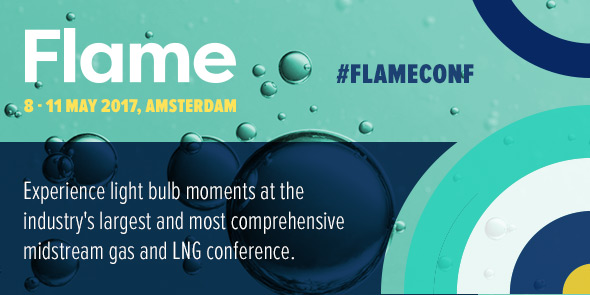LNG-Bunkers in SW-Europe

Written by Juan Carbayo Puig, Business Development Manager at Cepsa Gas Comercializadora. Juan will be participating in the panel discussion of "New small scale LNG markets" at Flame 2017.
LNG is a competitive, environmentally-friendly shipping fuel showing the potential to attract a significant share of the growing bunker markets globally.
Such growth might be reinforced price-wise by a futures scenario where LNG spreads to conventional bunker fuels return to wider, more favorable levels (e.g. high gasoil prices). The gas leg of such spreads could be capped by the steady increase of [non-conventional] LNG production. These growing exporting volumes keep boosting the relative weight of [spot] LNG in global gas markets. And spare LNG in turn enhances liquidity favoring price convergence between the three gas world basins. Ultimately, such ‘’commoditization’’ trend can translate into a clearer, cost-saving price signal in the long term, thus pointing at higher ROIs for shipowners.
But, apart from the top-on-the-agenda cost reduction, how to tempt shipowners to ‘embark on cryogenics’? Suppliers need to simply deliver (beyond duly making their ‘frozen gas’ available to the receiving vessel). Which also means assuming both social and environmental responsibility in a permanent quest for balancing energetic and economic sustainability.
In this sense, a proper coordination between all the stakeholders involved in the LNG-bunkers chain should be promoted. And at the same time each stakeholder needs to add value to the chain, by taking up their own respective business risks. Thus, freight rates risk should stay with ship-owners, whereas LNG bunker suppliers must on their side assume gas price risk linked with their long-term offers. This risk assumption is essential to guarantee short enough paybacks through OPEX savings from cheaper LNG fuelling. Owners do require them in order to offset their extra CAPEX from more-expensive-than-conventional LNG-powered (or retrofitted) vessels. In so accomplishing, the learning curve will be climbed faster and costs consequently reduced, paving thus the way for further competitive advantage.
In this fast-changing world, momentum has certainly grown for a global Energy policy envisioning cleaner fuels. This process follows the implementation of the NW-Europe and North-American SECAs and the COP-21, and was underpinned in October 2016 by the IMO decision for MARPOL annex-VI to become mandatory in 2020. Thereby, the world-wide cap on marine Sulphur emissions will be reduced to 0,5%, thus prompting ship owners to sharply readdress their current emissions-compliance approach to ‘wait & see’. LNG-powered vessels will then ‘emerge’ as a reasonable fuel-switching alternative.
Concerning safety and efficient operation, top down international, domestic and regional standards have just come out and more will follow. In this sense, let us consider on the one hand the two main efforts worldwide as recently released:
The mandatory IGF code that just entered into force at the beginning of 2017, which is specific for gas-fuelled vessels (as opposed to the older IGC code for gas carriers). IGF Code is intended to minimize the risk to ships, their crews, and the environment, while new amendments to the International Convention for the Safety of Life at Sea (SOLAS) require IGF code compliance.
The recently published ISO 20519:2017, a new LNG bunkering standard to promote safe and sustainable shipping, produced at the request of the IMO, the European Commission and the Baltic and International Maritime Council, the world’s largest international shipping association.
On the other hand, such global move is being replicated at a regional and national scale, and ultimately at a port dimension. An example of these much-detailed local standards is the recently approved ‘’Set of Conditions for Ship to Ship Deliveries of LNG Bunkers’’ in the port of Huelva, South-West Spain.
LNG refueling crucially relies on security of supply. Many European ports fulfill such requirement thanks to both the existence of a widespread grid of LNG infrastructures and the increasingly diversified portfolio of larger imports. Nevertheless, further investments are being focused mostly on the barging side.
Regarding SW-Europe in particular, most shipping routes go through Iberian Peninsula, which perfectly fits the reliable, extensive local supply network. The long-existing eight regasification terminals are getting ready to perform Small-Scale re-loadings for both Feeders or up-coming Bunkering vessels. In terms of distribution it is worth to point out the extensive fleet of three hundred semi-trailers that deliver more than 500 small-scale plants inland. In terms of LNG bunkers, Truck To Ship (TTS) deliveries are now feasible in basically all Spanish ports, and the first such operation was performed by Cepsa back in 2013.
Cepsa Gas Comercializadora is one of the main LNG shippers in the area, and intends to strengthen such leadership by increasing its sales to LNG bunker suppliers. In this sense, an LNG-ready Bunkering Vessel will be time-chartered from 2018 onwards by its bunkering-specialist shareholder Cepsa in Barcelona (Spain). Such infrastructure might effectively contribute to meet the eventual demand for LNG by ship-owners in that port.
